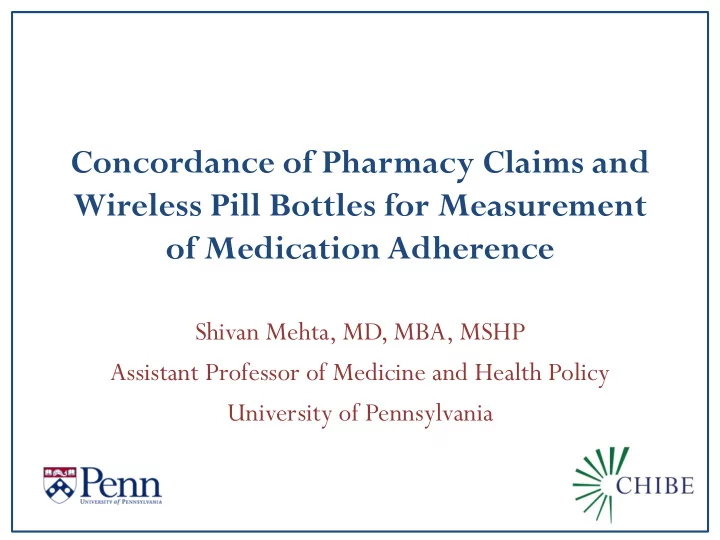

Concordance of Pharmacy Claims and Wireless Pill Bottles for Measurement of Medication Adherence Shivan Mehta, MD, MBA, MSHP Assistant Professor of Medicine and Health Policy University of Pennsylvania
Medication adherence post-MI With free medications, statin adherence increased from 49% to 55% Source: Jackevicius CA, et al JAMA, Choudhry et al NEJM
Measurement of Adherence Administration Accuracy Self report Moderate Questionable accuracy, and limited time frame Pill count Difficult Good accuracy, but challenging to administer Pharmacy claims Easy Most widely used, but only measures filling of meds Electronic pill Moderate Measures opening but bottles needs to be used properly
Objectives • Evaluate the concordance of pharmacy claims and wireless pill bottles for measuring medication adherence • Correlate medication adherence measures with clinical outcomes among myocardial infarction patients
Study context Pragmatic trial of heart attack patients randomizing 1509 in 2:1 ratio to the following intervention for 12 months : 1. Wireless pill bottles for cardiovascular meds 2. Engagement incentives with daily lotteries conditional on adherence 3. Social incentive - Friend or family member gets automate alerts 4. Assignment of an engagement advisor as needed
Methods • Include participants in the intervention group (n=1003) for whom we had 12 months of pharmacy data ( n=456 ) – Pharmacy claims adherence measured using proportion of days covered (PDC) – Pill bottle adherence measured using percent of days with cap opening • Clinical outcome was time to first vascular readmission or death
Medication adherence measures Pharmacy claims Electronic pill bottles Strict Prescribed medication Adherence measurement for for entire study period entire study period for study medication Intermediate Prescribed medication for Adherence measurement for the entire study period if entire study period if they ever they ever filled that opened a bottle medication after discharge Relaxed Prescribed medication from Adherence from the first bottle time of first fill until the end opening date of the study period
Statistical analysis • Pearson correlation coefficient (r) of the annual adherence measures • Unadjusted cox proportional hazard models used to evaluate association of clinical outcomes and adherence to statins – Model fit examined with Akaike information criteria (AIC) and Bayesian information criteria (BIC) – Additional value of both adherence measures using likelihood ratio (LR) test
Patient characteristics 12-month continuous coverage N 456 Female, No. (%) 160 (35.1) Age, Mean (SD) 61.9 (10.2) Medicare, No. (%) 253 (55.5) Baseline Elixhauser Score, Mean (SD) 6.5 (10.1) # Days Between Index Discharge and Enrollment, Mean (SD) 40.9 (12.0) Region, No. (%) …Northeast 138 (30.3) …Midwest 75 (16.5) …South 212 (46.5) …West 31 (6.8)
Pharmacy claims data PDC Statin 1 .9 .8 .7 .6 .5 .4 .3 .2 .1 0 0 30 60 90 120 150 180 210 240 270 300 330 360 Days Since Enrollment Strict Intermediate Relaxed
Electronic pill bottle data GlowCap Statin 1 .9 .8 .7 .6 .5 .4 .3 .2 .1 0 0 30 60 90 120 150 180 210 240 270 300 330 360 Days Since Enrollment Strict Intermediate Relaxed
Correlation of two measures Statin Adherence (PDC vs GlowCap) 1 .8 .6 PDC .4 .2 0 0 .2 .4 .6 .8 1 GlowCap • Annual statin adherence using PDC = 0.73 and GC = 0.70. • Pearson’s r = 0.14 (p = 0.004)
Results • GC statin adherence and time to first vascular event was statistically significant (HR = 0.327; 95% CI = 0.150 - 0.711; p = 0.01). • PDC statin adherence and time to vascular event was not statistically significant (HR = 0.633; 95% CI = 0.258 – 1.556; p=0.32). • Adding the GC adherence variable to the model using only PDC improved the model fit (LR test p = 0.009), but not vice versa (p = 0.51).
Conclusion • Pharmacy claims and electronic pill bottle data were correlated, but with missing data • Electronic pill data had greater association with clinical outcomes than pharmacy claims alone and when combined • Policies and programs that rely on pharmacy claims may not fully account for medication adherence
Study Team • David A. Asch, MD, MBA Funding: • Andrea B. Troxel, ScD Center for Medicare & Medicaid Innovation, Health • Raymond Lim, MA Care Innovation Award • Jennifer Lewey, MD, MPH 1C1CMS331009 • Wenli Wang, MS • Jingsan Zhu, MBA • Laurie Norton, MA • Noora Marcus, MA • Kevin G. Volpp, MD, PhD
Recommend
More recommend